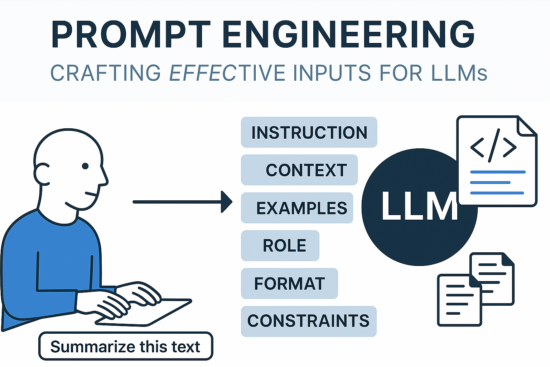Introduction
In the rapidly evolving landscape of artificial intelligence, prompt engineering has emerged as a pivotal skill. It involves crafting effective inputs (prompts) to guide large language models (LLMs) like GPT-4, Claude, and others to produce desired outputs. Whether you’re a developer, data scientist, content creator, or business professional, understanding prompt engineering can significantly enhance your interactions with AI models.
This tutorial delves deep into the principles, techniques, and best practices of prompt engineering, providing you with the tools to harness the full potential of LLMs.

Table of Contents
1. Understanding Prompt Engineering
Prompt engineering is the art and science of designing inputs that effectively instruct AI models to perform specific tasks. Given that LLMs are trained on vast datasets and can generate diverse outputs, the way you phrase your prompt can significantly influence the model’s response.
Why is Prompt Engineering Important?
-
Precision: Well-crafted prompts lead to more accurate and relevant outputs.
-
Efficiency: Reduces the need for multiple iterations to get the desired result.
-
Control: Allows users to steer the model’s behavior and tone.
-
Versatility: Enables the use of LLMs across various domains and tasks.
2. Core Components of Effective Prompts
An effective prompt typically includes the following components:
a. Instruction
Clearly state what you want the model to do.
Example:
“Summarize the following article in three bullet points.”
b. Context
Provide background information or data necessary for the task.
Example:
“Based on the 2023 financial report, identify the top three performing departments.”
c. Input Data
Include the text, data, or information the model needs to process.
Example:
“Given the following customer reviews, determine the overall sentiment.”
d. Output Format
Specify the desired format of the response.
Example:
“List the steps in a numbered format.”
e. Tone and Style
Indicate the tone or style you want the model to adopt.
Example:
“Write the response in a formal tone suitable for a business report.”
3. Prompting Techniques
Various techniques can enhance the effectiveness of your prompts:
a. Zero-Shot Prompting
Instructing the model without providing examples.
Example:
“Translate ‘Good morning’ to French.”
b. Few-Shot Prompting
Providing a few examples to guide the model.
Example:
“Translate the following phrases to French:
‘Good morning’ -> ‘Bonjour’
‘Thank you’ -> ‘Merci’
‘Good night’ ->”
c. Chain-of-Thought Prompting
Encouraging the model to reason through the problem step-by-step.
Example:
“If a train travels at 60 km/h for 2 hours, how far does it go? Let’s think step by step.”
d. Role Prompting
Assigning a specific role to the model to influence its response.
Example:
“You are a professional chef. Provide a recipe for a vegan lasagna.”
e. Multi-Turn Prompting
Engaging in a conversation with the model, building context over multiple interactions.
Example:
User: “What’s the capital of France?”
AI: “Paris.”
User: “Tell me more about it.”
4. Best Practices in Prompt Engineering
To craft effective prompts, consider the following best practices:
a. Be Clear and Specific
Ambiguity can lead to unexpected results. Clearly define the task and desired outcome.
Instead of: “Tell me about dogs.”
Use: “Provide a brief overview of the physical characteristics and common behaviors of Labrador Retrievers.”
b. Provide Context
Supplying relevant information helps the model generate accurate responses.
Example:
“As a travel agent, suggest three family-friendly destinations in Europe for the summer.”
c. Specify the Output Format
Guiding the model on how to structure its response ensures consistency.
Example:
“List the pros and cons of remote work in bullet points.”
d. Set the Tone
Indicate the desired tone to match the intended audience.
Example:
“Write a casual blog post about the benefits of morning exercise.”
e. Iterate and Refine
Experiment with different prompt structures to achieve the best results.
5. Common Pitfalls and How to Avoid Them
Being aware of common mistakes can enhance your prompt engineering skills:
a. Overly Broad Prompts
Issue: Vague prompts can lead to irrelevant or generic responses.
Solution: Narrow down the scope and be specific.
b. Lack of Context
Issue: Without context, the model may make incorrect assumptions.
Solution: Provide necessary background information.
c. Ignoring Output Format
Issue: Unspecified formats can result in inconsistent outputs.
Solution: Clearly define the desired structure.
d. Overloading the Prompt
Issue: Including too much information can confuse the model.
Solution: Keep prompts concise and focused.
6. Real-World Applications
Prompt engineering has diverse applications across various domains:
a. Business
-
Drafting emails and reports.
-
Summarizing meeting notes.
-
Generating business plans.
Example:
“Summarize the following meeting transcript into key action items.”
b. Education
-
Creating quizzes and study guides.
-
Explaining complex concepts.
Example:
“Explain the theory of relativity in simple terms suitable for high school students.”
c. Healthcare
-
Simplifying medical jargon for patients.
-
Drafting patient summaries.
Example:
“Translate the following medical report into layman’s terms.”
d. Software Development
-
Generating code snippets.
-
Explaining code functionality.
Example:
“Write a Python function to calculate the factorial of a number.”
e. Creative Writing
-
Generating story ideas.
-
Writing poems or dialogues.
Example:
“Write a short story about a time-traveling detective.”
7. Future of Prompt Engineering
As AI models evolve, prompt engineering will continue to play a crucial role. Emerging trends include:
-
Automated Prompt Generation: Tools that assist in crafting effective prompts.
-
Prompt Libraries: Collections of tested prompts for various tasks.
-
Integration with Other Technologies: Combining prompt engineering with tools like APIs and databases for enhanced functionality.
8. Conclusion
Prompt engineering is a vital skill in the AI era, enabling users to effectively communicate with language models to achieve desired outcomes. By understanding the core components, employing various techniques, and adhering to best practices, you can harness the full potential of AI models in your personal and professional endeavors.




